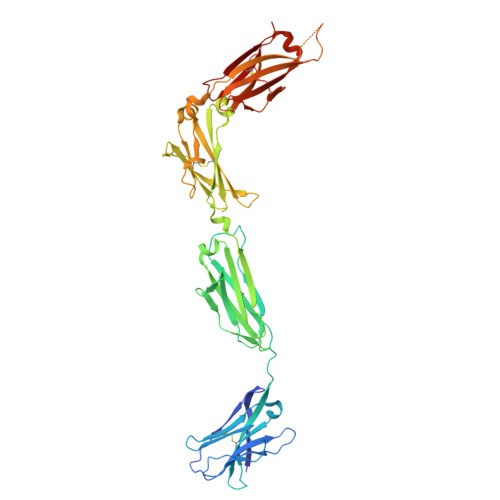Origin of immunoglobulins and T cell receptors: A candidate gene for invasion by the RAG transposon.
Flajnik, M.F., Stanfield, R.L., Verissimo, A., Neely, H.R., Munoz-Merida, A., Criscitiello, M.F., Wilson, I.A., Ohta, Y.(2025) Sci Adv 11: eadw1273-eadw1273
- PubMed: 40614193
- DOI: https://doi.org/10.1126/sciadv.adw1273
- Primary Citation of Related Structures:
9DMX - PubMed Abstract:
Rearranging antigen receptors (AgRs) arose when a variable (V) domain exon was invaded by the recombination-activating gene (RAG) transposon ~500 million years ago. We show here that the elasmobranch immunoglobulin heavy (IgH) isotypes-IgM, IgW, and IgNAR-are linked near the αδ T cell receptor (TCRαδ) locus. This linkage presages the emergence of the osteichthyan IgH translocon arrangement and clarifies the relationship between IgH and TCRδs. Recently, we reported UrIg , a nonrearranging, elasmobranch major histocompatibility complex (MHC)-linked AgR gene. Here, we describe a nonrearranging UrIg paralogue, UrIg2 , linked to this IgM/IgNAR/IgW/TCRαδ gene cluster in an AgR complex (AgRC). UrIg2 amino-terminal domains make homodimers where the C2-C3 structure resembles IgGFc. A relative of the UrIg2 V domain exon was invaded by the RAG transposon, revealing the genesis of the adaptive immune system. Our data indicate that an ancestral chromosome encoded an AgR precursor, undergoing RAG-mediated rearrangement after genome-wide duplication on one chromosome and retaining nonrearranging relics in the MHC and AgRC.
Organizational Affiliation:
Department of Microbiology and Immunology, University of Maryland School of Medicine, Baltimore, MD 21201, USA.




















